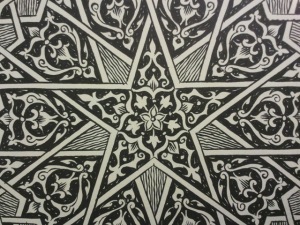(Warning: Spoilers)
This week, I finished reading Habibi, the epic-length graphic novel by writer and artist Craig Thompson. [1]
From the Divine Pen fell the first drop of ink.
And from the drop, a river…
When the land dried up with drought, my parents sold me into marriage.
As the lead narrator Dodola explains, the Arabic word habibi means “my love” or “my darling.” Dodola, sold into marriage as a child and then kidnapped by raiders, uses this word to rename an enslaved black toddler she flees into the desert with. Together, she and Cham (Zam) live among the dunes in an abandoned boat until Dodola is abducted again and Zam goes to the nearest town to look for her.
There’s a Lot to Love about Habibi
Thompson has crafted a nine-chapter story that combines dialogue, emotion, rapidly evolving characters, dream-like reflection, vivid acts of violence, poetry, scriptures, and art in a whole that shouldn’t cohere, but does.
I’ll be keeping the book on my reference shelf, not for its plot, but for Thompson’s numeric and ink work. The section dividers are all based on geometric patterns, themselves based on geometric and numerological grids in a visual style that’s both beautiful and striking. It will be one of the books I’ll study to learn about lines and the contrasts of lights and darks.
And when I get lost in this art, I love that the characters use story to build a sprawling safe haven for each other amidst experiences and cultural forces that are brutally limiting.
But it’s Arab-ish, not Arabic
This is not an Arabic story. It’s what an American imagined an Arabic coming-of-age/resilience myth might look like if set on an unspecified Near East landscape with no Western participants and no hint of the religion- and oil-tinged geopolitics, nation-state instability, or cyclical populism that have characterized the actual Near East over the last several years.
In fact, the currency of power in this novel isn’t oil at all, but water. Readers who’ve seen Daniel Craig’s Bond in Quantum of Solace will find this familiar, especially given recent military intelligence estimates about future conflicts based on access to and control of water. A British cabinet minister also extended this warning last March. Note, too, that all three of these sources—the Bond franchise, the US. Director of National Intelligence, and the British secretary of energy and climate change—are Westerners gazing at Mesopotamia and the Fertile Crescent.
Religion, so influential in Arab nations today, is a transitional narrative device in Habibi, and the stories held as sacred across religions prop up characters’ self-apprehension: Thompson uses Islamic and Jewish religious myths to deepen characters’ backstory or context. Some thoughtful detours into the literature of regional religions prevent the novel from being a 672-page ahistorical projection—but only just. There’s something of an authenticity deficit here.
So There Are Some Barriers to Full Endorsement
If you google Habibi, you’ll notice several substantive reviews by people far more versed in Arabic cultures, literature, and story-telling traditions than I am. [2] One recurring criticism is rooted in the fact that Habibi is Orientalist exotica predicated on an Occidental caricature of the rest of the world. Thompson also foregrounds this perspective in some of his promotional and post-publication interviews. [3]
A result of Habibi’s Othering is Thompson’s rendering of women, female agency, and female sexuality along the story arc; another is his essentialist depictions of Arab and black characters throughout. We’re expected to assume we’re in a mythic world where racialist hierarchies and the enslavement of children and women are normal and immutable (and the lead characters participate in this trade in the final chapter). But at the same time, when Thompson draws callous acts in ways calculated to trigger reader disgust, we’re clearly led to disapprove and to root for the escaping slaves rather than their traders or abusers.
This mash-up produces an ambiguous literary morality and something of a lost opportunity for a writer who clearly has researched. His research could have supported an alternative to the totalizing gaze Western readers are so accustomed to already, but ultimately it did not. In his Comic Con interview, Thompson says that he didn’t view Habibi as mere “escapist fantasy” though he was inspired by the fantasy of 1,001 Arabian Nights; he wanted to “humanize” Islamic culture though he tells one reviewer (Damluji) that the lead characters predated American Islamophobia… How does this all work? It doesn’t.
As much as the structural elements of the book cohere—the dialogue, emotion, character, reflection, violence, poetry, scriptures, and art—Thompson’s “Aw, shucks: it’s still just a comic!” and the “I wanted to humanize Islamic culture!” don’t cohere. He “enjoys the conflict” between these elements, but for this reader just a comic trumps sweeping consequence. I hope other artists who don’t minimize the ethics of representation or the potential of the graphic novel as a genre will challenge Thompson on these questions over time. He has incredible talent.
I’ve rated Habibi with 3 stars on Goodreads.
—
[1] Thompson, Craig. (2011). Habibi. Pantheon. (672 pages | hardcover)
[2] Sample reviews: Michael Faber in the Guardian; Nadim Damluji at The Hooded Utilitarian. Damluji’s review contains several more images from Habibi. I noticed that Damluji credited Thompson for humanizing Islam, but Thompson proposed humanizing Islamic culture. These are very different goals.
[3] Sample interviews: at New York Magazine; with Nadim Damluji; at San Diego Comic Con 2011; and at Mother Jones).
